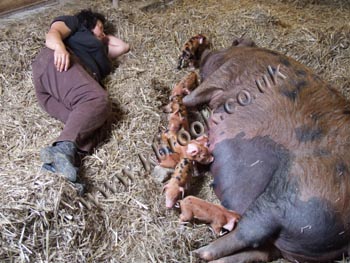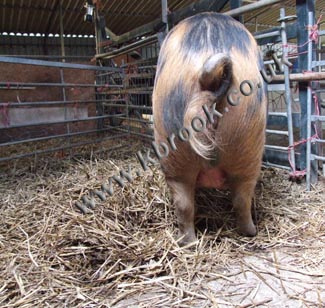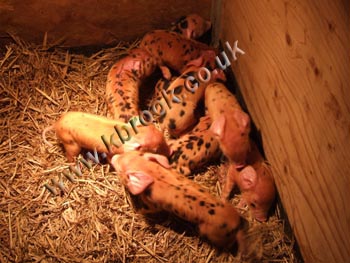PIG FARROWING

Please remember that every farrowing is different. Pig farrowing is a topic which is always filled with great excitement. But for all its wonder and emotion related to the parturition creation it is to be approached with caution and experience and a stress free atmosphere must be put into action for both you and your Oxford Sandy & Black sow in pig.
Make sure that you plan your farrowings, as it is no good to have a farrowing whilst you are on holiday or you plan a party around the time of a farrowing.
Pigs quite often have stillbirths or re-absorb embryos. Embryos are not embedded until day nine of gestation and at that stage they can migrate from one horn (side of the uterus) to another, so if all embryos are lost in one horn they can migrate from the other one. As long as there are four embryos in place, and both horns are occupied, pregnancy continues beyond ten days, otherwise it appears to be terminated. After twelve days the number of embryos may be reduced to as few as one and the pregnancy will still continue. Litters of four or less are suggestive of embryonic death between twelve and thirty days of gestation. Embryos destroyed before day thirty-five of gestation are absorbed, as they have not yet begun skeletal calcification and sometimes foetuses can become mummified if they die after thirty days. Older sows have a higher percentage of stillbirths than younger sows but this may be connected with litter size, as older sows tend to have larger litters with smaller piglets than do younger pigs. There are various causes of abortion, stillbirths and foetal deaths; these include bacterial or viral infections, nutritional deficiencies, poisoning and so forth.
A pig’s gestation period is one hundred and sixteen days from the day they are serviced. A few days either side is nothing to worry about however if a week has passed it would be advisable to have her scanned.
At three months of pregnancy I feed my girls food that is high in nutrients especially vitamin A such as spinach, curly kale, raisins, dried apricots and broccoli this is because at this stage in their birth their body stops producing fat and begins to break down their fat to produce milk and it is also at this stage the piglets are putting on their growth rate. Females can put on a pound a day during gestation. A few days before birth I monitor the food as if they are overfed the sow can become constipated and her gut distended. This can result in constriction of the reproductive tract, giving problems to birthing. Watch out for scouring (diarrhoea) as this can lead to dehydration, which can make milk production more difficult. Basically, I feed a little less over three days before the birth being careful not to totally alter the feeding routine. It is useful for sows (pregnant or not) to be kept on grass (not mud) to build up their supplies of vitamin and mineral reserves from the foliage and soil; the exercise also prevents them from becoming too heavy.
Sows in pig are to be separated from the rest of the herd two weeks before farrowing. This will give them time to settle themselves in their farrowing pens, also separating them from others where potential barging around for food could happen therefore causing stress and pain during these important times. It goes with out saying that stress and strain should be avoided at this time as this can lead to abortion. Cold draughty housing, too hot housing, damp housing, hilly land, steps, sudden noise (particularly around Bonfire Night, Christmas and New Year time where fireworks are popular), or being transported very close to the birth (those wishing to purchase sows in pig should be mindful of this).
This is the time when you should be treating the sow for external parasites and therefore worming her a week before she gives birth to avoid placenta crossover of womb infestation. It is also a good idea to vaccinate against Erysipelas three weeks before farrowing and if the mother has never been vaccinated before she will need one injection six weeks prior to farrowing and a booster three weeks later.
I bring my girls in for farrowing this is because I can be on hand at the birth should I be needed. It is also safer for the piglets when they enter into the world, as they are so at risk with predators such as the fox, magpies, crows and buzzards. Getting lost which will result in freezing to death as they are like to roam when they are up on their feet, which is just a matter of seconds!
Pigs that are kept in the traditional way will show signs of making a nest by carrying straw about or pushing it around their chosen spot within their pen in preparation for the birth.
The farrowing pen should be cleaned and disinfected at least a week before the sow is brought in. With a little bedding not too much as piglets so often like to burrow in the straw and can get lost, trampled by the mother or at worse suffocate.

The infrared lights (there are two colours red and white, I find the white is better for the pigs and the red for the birds) should be put on a few days before the litter is born. And much to my disapproving husband the lights are left on for three weeks day and night this is so mum can see babies and babies can see mum thus avoiding mum accidentally lying on her babies. It is safe to say that after one week the babies know when mum is about to lie down and are quick on their feet but it is in the night where the problems come so just for the sake of three weeks and the lives of your piglets who have taken over three months to be born it is little to ask.
Make sure that you wash the udders and make sure she is generally clean prior to birth.
So the birth is about to happen. It is worth making sure you are around for the births, even if they are in the middle of the night. Also you will be a great help in those winter nights when it is cold you can help dry the piglets off as they come out.
You will notice that the sows abdomen will drop so much so that when you look from behind between her back legs it is almost touching the ground – referred to as “bagging up”. She will also start to carry straw from one area to another; will generally throw things around as she is having contractions.

From the moment this happens it is generally six hours until birthing is imminent. When she has made her circle of straw (very impressive nest whereby I have also slept) she will lie down her breathing will become laboured and if she is a gilt from her vulva will come a very dark (almost black in colour) discharge (I have not noticed this dark discharge in subsequent farrowings) at this stage her vulva will be a very dark red and swollen and then slowly but surely you will see the first piglet emerge. Sometimes they pop out unassisted breaking the air sac and walking round to the mother to latch on to a teat straight away other times you will have to break the air sac and clean around their faces.
It is best to have the babies under the heat lamp in the creep area and wait for the mother to finish giving birth and when this is done then put all babies on a teat and watch them have their first feed during this time spray all umbilical cords with antiseptic spray to prevent infection and (do not cut the piglets umbilical cord, they will shrivel up over the first day or so. If a piglet is constantly catching the cord and pulling its stomach then at this stage you may cut it but please remember to go over the cut area with an antibiotic spray immediately) make sure all are feeding quietly.
It takes between six and eight hours from the moment the first piglet is born to the two afterbirths passing out and make sure there are two that are passed out one from each horn. These are normally passed out three hours after the birth of the last piglet is born.
As most of you will know the first suckle of milk from the mother is vital as it contains colostrum which helps give them early immunity to various infections with the highest level of immunity present in the first twenty four hours. Although the colostrum starts declining rapidly about six hours after farrowing commences, as does the piglets response to it. When all the piglets have been born and the afterbirths expelled you can make sure the birthing area is clean and dry and that all piglets are feeding happily if all is quiet they are probably all getting the nourishment they need. If one or more are constantly squeaking there is probably a problem that needs tending too.
The piglets are born with their ears folded back and they start to come forward within 2 to 3 days. The piglets will feed regularly every 20 minutes for the first 48 hours and then every half hour in the first couple of days to an hour after a week and so on. At about three weeks they are now able to go outside providing it is not too cold, wet or boggy underfoot. If the weather is too harsh, and normally January farrowings the weather is so I tend to leave the mother with their babies inside (where I get no complaints) and introduce toys suspended from the ceiling (which is always greeted with a shake of the head and eyes looking upwards from my beloved husband), to keep the piglets stimulated, I also have a radio and have it switched off at night time. In summer, it is a different story, the radio is still on, but it may be too hot for heat lamps so at night I have a little night lamp on every night for three weeks just so everybody can see each other. I also keep the farrowing pen doors closed at night until the piglets are at least three weeks old as the risk of them wandering off at night is limited also predators will be unable to sneak in.
In summer during the pregnancy the sow will be very warm where I have had to give showers every two hours and have a fan on which is greatly appreciated. Water sprayed on concrete floors is an added bonus as it helps in the cooling process.